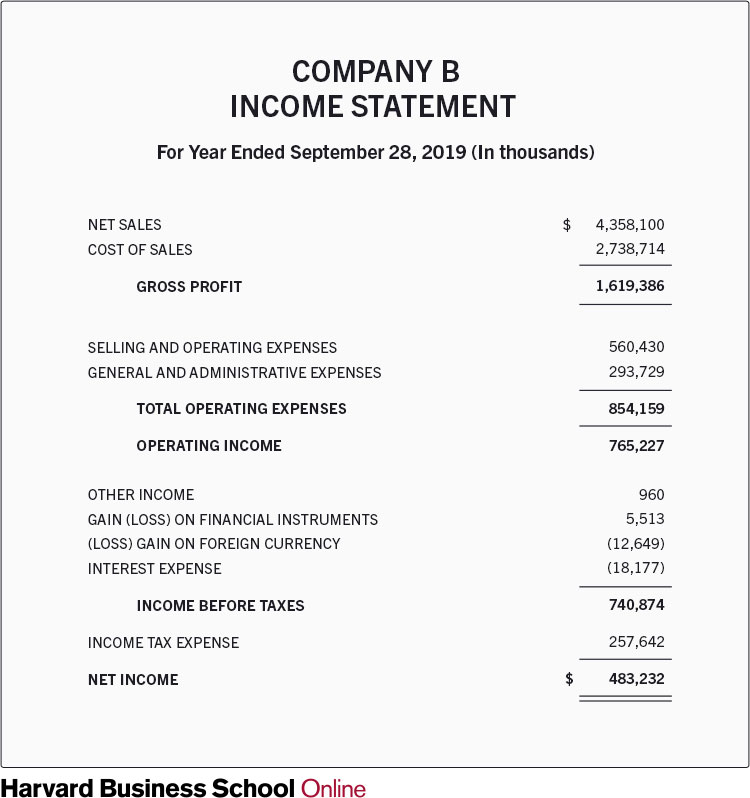When it comes to financial statements, each communicates specific information and is needed in different contexts to understand a company’s financial health.
The income statement is one of the most important financial statements because it details a company’s income and expenses over a specific period. This document communicates a wealth of information to those reading it—from key executives and stakeholders to investors and employees. Being able to read an income statement is important, but knowing how to generate one is just as critical.
Here’s an overview of the information found in an income statement, along with a step-by-step look at the process of preparing one for your organization.
Free E-Book: A Manager's Guide to Finance & Accounting
Access your free e-book today.
DOWNLOAD NOWWhat Is an Income Statement?
An income statement is a financial report detailing a company’s income and expenses over a reporting period. It can also be referred to as a profit and loss (P&L) statement and is typically prepared quarterly or annually.
Income statements depict a company’s financial performance over a reporting period. Because the income statement details revenues and expenses, it provides a glimpse into which business activities brought in revenue and which cost the organization money—information investors can use to understand its health and executives can use to find areas for improvement.
Related: How to Read & Understand an Income Statement
An income statement typically includes the following information:
- Revenue: How much money a business took in during a reporting period
- Expenses: How much money a business spent during a reporting period
- Costs of goods sold (COGS): The total costs associated with component parts of whatever product or service a company makes and sells
- Gross profit: Revenue minus costs of goods sold
- Operating income: Gross profit minus operating expenses
- Income before taxes: Operating income minus non-operating expenses
- Net income: Income before taxes
- Earnings per share (EPS): Net income divided by the total number of outstanding shares
- Depreciation: Value lost by assets, such as inventory, equipment, and property, over time
- EBITDA: Earnings before interest, depreciation, taxes, and amortization
Related: 13 Financial Performance Measures Managers Should Monitor
Steps to Prepare an Income Statement
1. Choose Your Reporting Period
Your reporting period is the specific timeframe the income statement covers. Choosing the correct one is critical.
Monthly, quarterly, and annual reporting periods are all common. Which reporting period is right for you depends on your goals. A monthly report, for example, details a shorter period, making it easier to apply tactical adjustments that affect the next month’s business activities. A quarterly or annual report, on the other hand, provides analysis from a higher level, which can help identify trends over the long term.
2. Calculate Total Revenue
Once you know the reporting period, calculate the total revenue your business generated during it.
If you prepare the income statement for your entire organization, this should include revenue from all lines of business. If you prepare the income statement for a particular business line or segment, you should limit revenue to products or services that fall under that umbrella.
3. Calculate Cost of Goods Sold (COGS)
Next, calculate the total cost of goods sold for any product or service that generated revenue for your business during the reporting period. This encompasses direct and indirect costs of producing and selling products or services, including:
- Direct labor expenses
- Material expenses
- Parts or component expenses
- Distribution costs
- Any expense directly tied to the production of your product or service
4. Calculate Gross Profit
The next step is to determine gross profit for the reporting period. To calculate this, simply subtract the cost of goods sold from revenue.
5. Calculate Operating Expenses
Once you know gross profit, calculate operating expenses (OPEX).
Operating expenses are indirect costs associated with doing business. These differ from cost of goods sold because they’re not directly associated with the process of producing or distributing products or services. Examples of expenses that fall under the OPEX category include:
- Rent
- Utilities
- Overhead
- Office supplies
- Legal fees
6. Calculate Income
To calculate total income, subtract operating expenses from gross profit. This number is essentially the pre-tax income your business generated during the reporting period. This can also be referred to as earnings before interest and taxes (EBIT).
7. Calculate Interest and Taxes
After calculating income for the reporting period, determine interest and tax charges.
Interest refers to any charges your company must pay on the debt it owes. To calculate interest charges, you must first understand how much money you owe and the interest rate being charged. Accounting software often automatically calculates interest charges for the reporting period.
Next, calculate your total tax burden for the reporting period. This includes local, state, and federal taxes, as well as any payroll taxes.
8. Calculate Net Income
The final step is to calculate net income for the reporting period. To do this, subtract interest and then taxes from your EBIT. The number remaining reflects your business’s available funds, which can be used for various purposes, such as being added to a reserve, distributed to shareholders, utilized for research and development, or to fuel business expansion.
Income Statement Example
Below is an example income statement for a fictional company. As you can see at the top, the reporting period is for the year that ended on Sept. 28, 2019.

Go to the alternative version.
During the reporting period, the company made approximately $4.4 billion in total sales. It cost the business approximately $2.7 billion to achieve those sales. As a result, gross profit was about $1.6 billion.
Next, $560.4 million in selling and operating expenses and $293.7 million in general administrative expenses were subtracted. This left the company with an operating income of $765.2 million. To this, additional gains were added and losses subtracted, including $257.6 million in income tax.
At the bottom of the income statement, it’s clear the business realized a net income of $483.2 million during the reporting period.
A Critical Skill for Business Leaders
Although the income statement is typically generated by a member of the accounting department at large organizations, knowing how to compile one is beneficial to a range of professionals.
Whether you’re an individual contributor, a member of the leadership team in a non-accounting role, or an entrepreneur who wears many hats, learning how to create an income statement can provide a deeper understanding of the financial metrics that matter to your business. It can also help improve your financial analysis capabilities.
Do you want to take your career to the next level? Consider enrolling in Financial Accounting—one of three courses comprising our Credential of Readiness (CORe) program—which can teach you the key financial topics you need to understand business performance and potential. Not sure which course is right for you? Download our free flowchart.
Data Tables
Company B Income Statement
For Year Ended September 28, 2019 (In thousands)
| Activity | Amount |
|---|---|
| Net Sales | 4,358,100 |
| Cost of Sales | 2,738,714 |
| Gross Profit | 1,619,386 |
| Selling and Operating Expenses | 560,430 |
| General and Administrative Expenses | 293,729 |
| Total Operating Expenses | 854,159 |
| Operating Income | 765,227 |
| Other Income | 960 |
| Gain (Loss) on Financial Instruments | 5,513 |
| (Loss) Gain on Foreign Currency | (12,649) |
| Interest Expense | (18,177) |
| Income Before Taxes | 740,874 |
| Income Tax Expense | 257,642 |
| Net Income | 483,232 |





